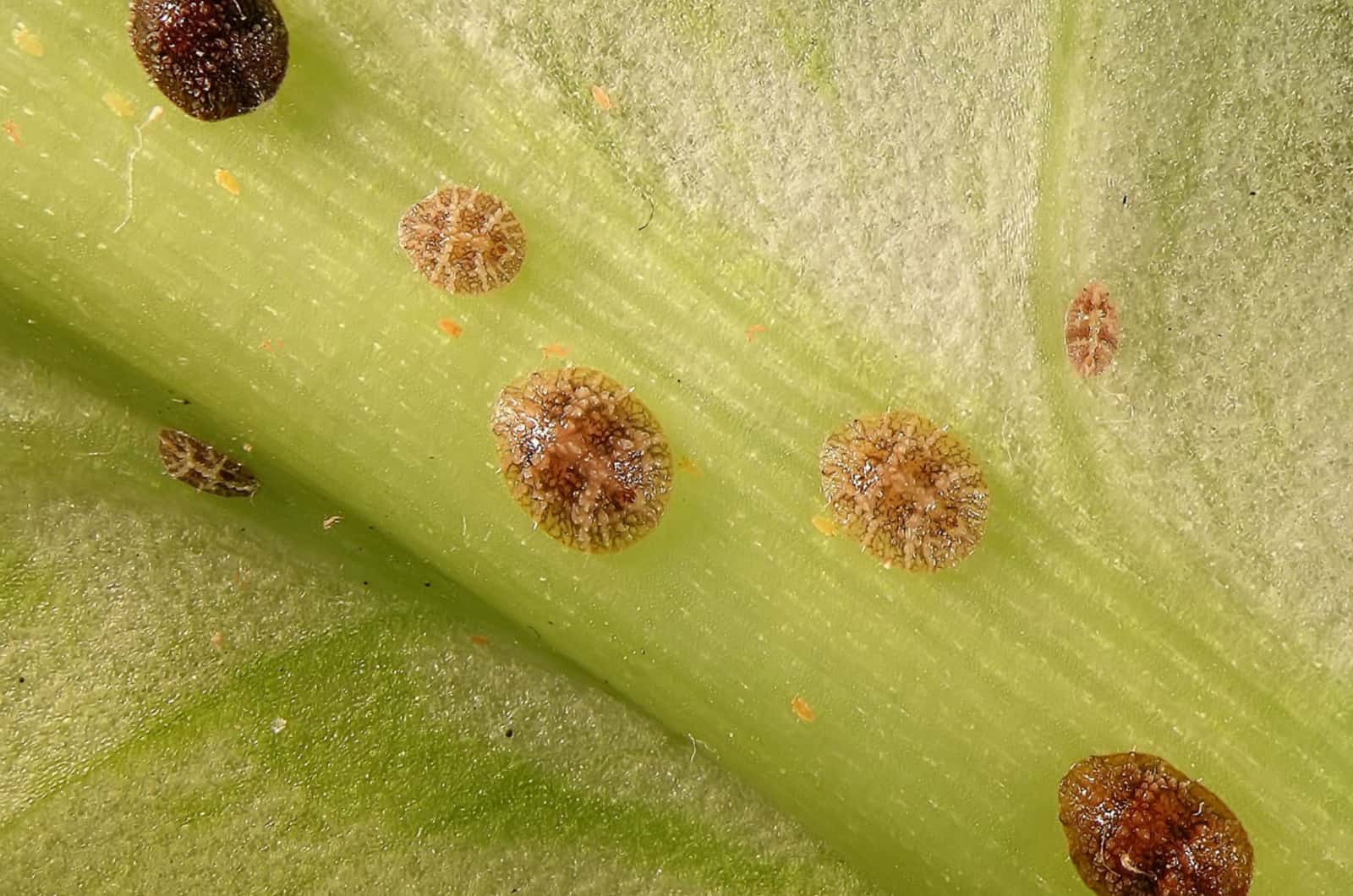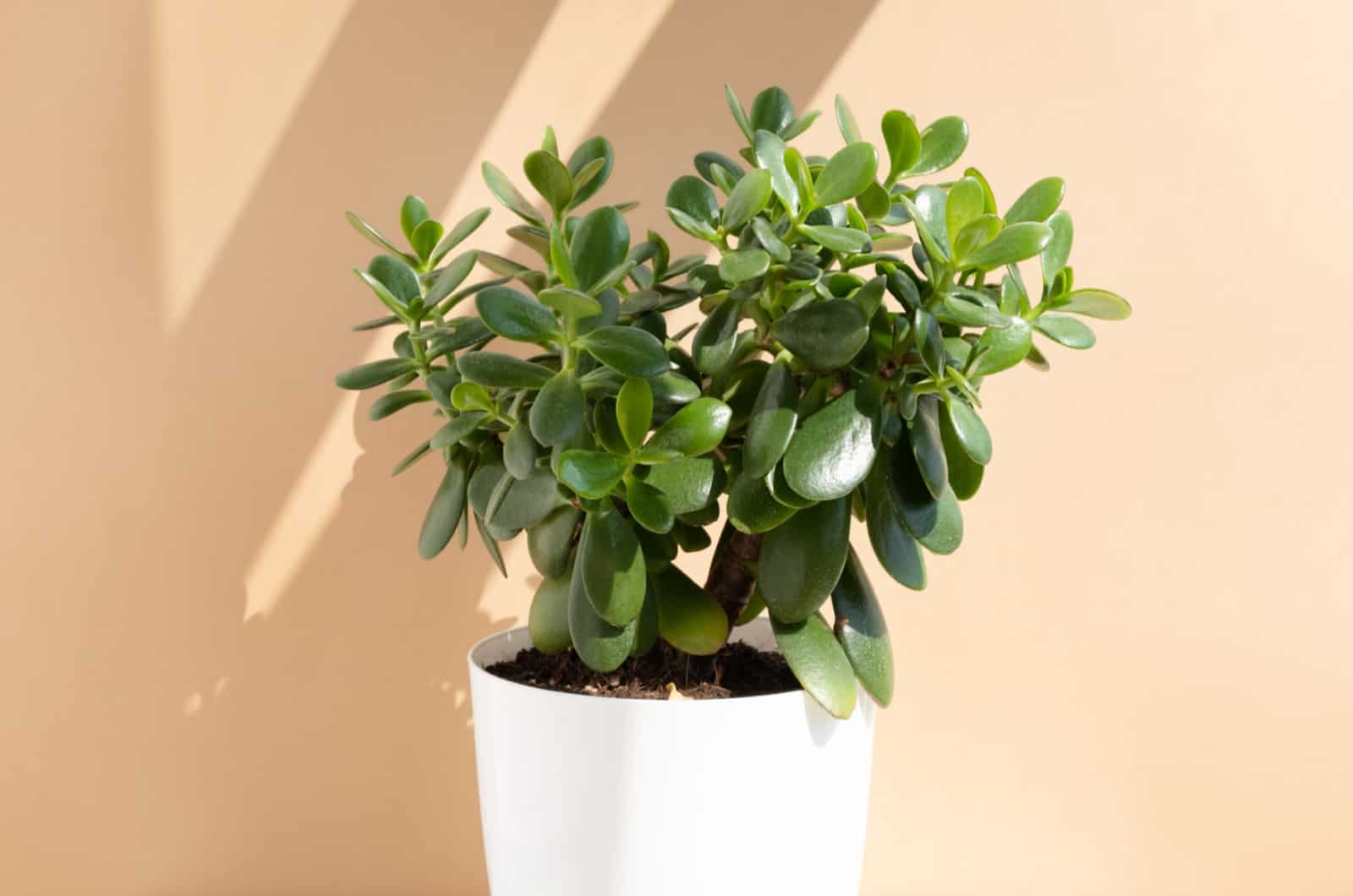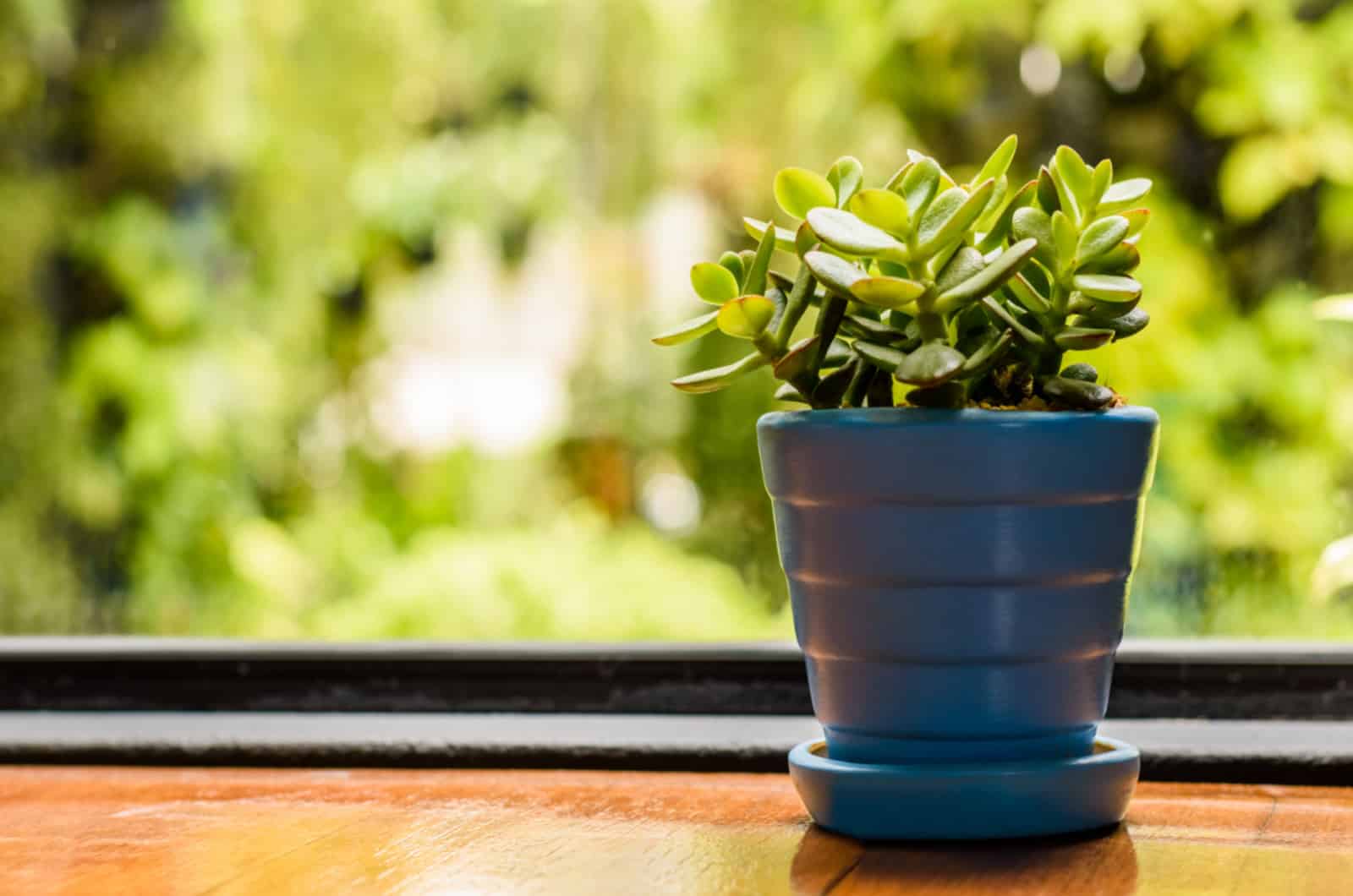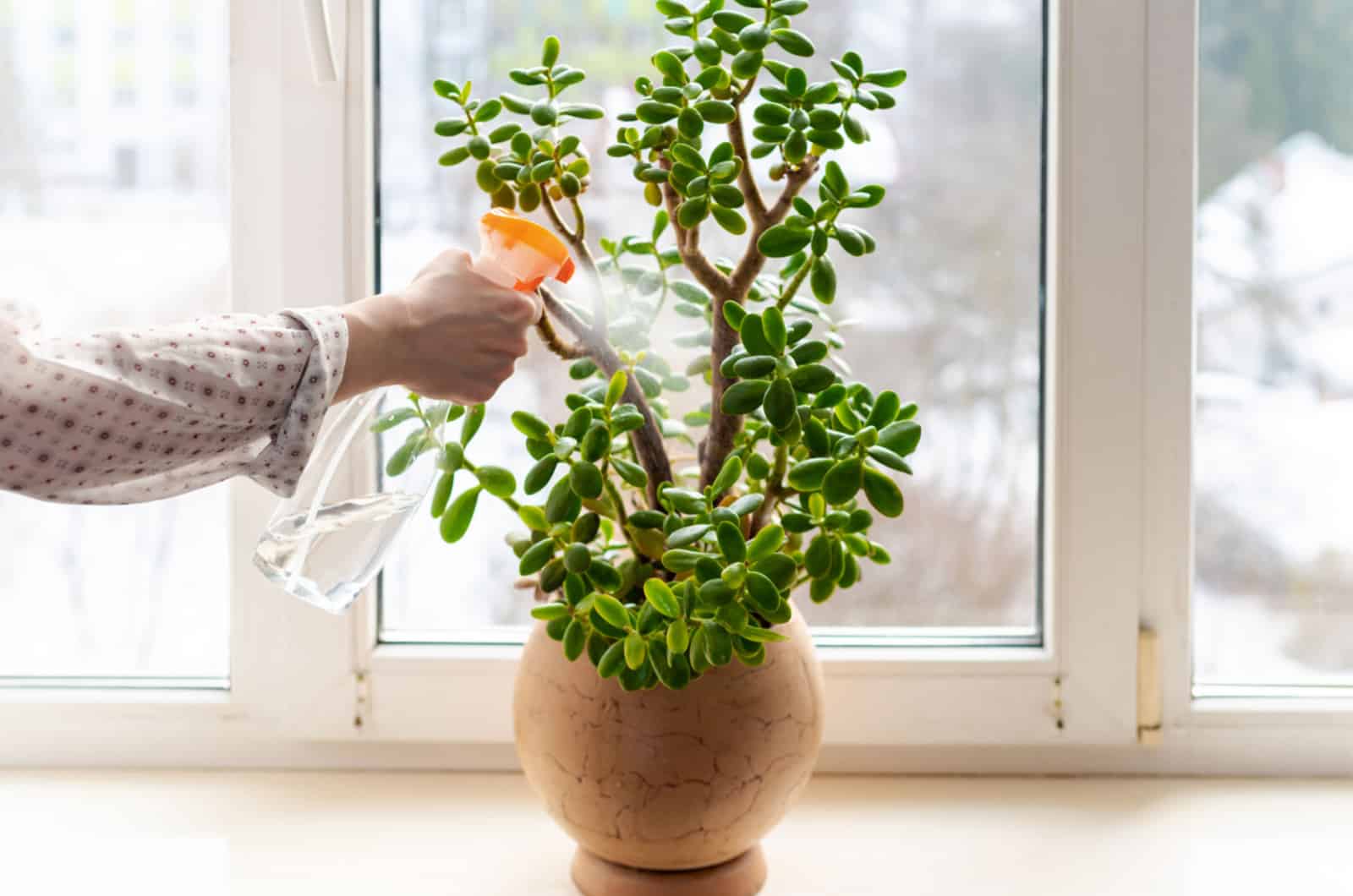No matter how long you have been growing plants, pests will always be a worry.
They aren’t attractive, they spread quickly and are barely visible, and they can severely damage and kill plants.
If you have scale on jade plant, it’s a problem, but if you spot it on time and treat it correctly it won’t do much damage and your Crassula ovata will be healthy and thriving again in no time!
Today I’ll teach you how to recognize these tiny pests on your jade plant, and also how to get rid of scale once and for all.
Always remember that preventing pests in the first place is the best way to deal with them.
I’ll also show you the best methods for pest prevention so that scale and other pests don’t infest your precious houseplants.
Let’s get started!
How To Recognize Scale On Jade Plant
Scale are tiny insects covered in a protective coating somewhat like a shell. Their mouth remains attached to the jade plant for most of their life cycle.
Scale come in two forms, armored and soft scales. Soft scales are more easily eliminated than armored ones as they are protected by a waxy material.
To protect itself from predators, the armored scale produces a tough shell around its body. The problem lies in the fact that pesticide has a hard time getting to the bug inside its shell.
Of course, the jade plant isn’t the only houseplant affected by scale insects. They can easily spread to other indoor plants, which is why it’s essential to get rid of them as soon as possible.
The problem with these tiny creatures is that you’ll rarely discover only one scale on jade plant leaves – they frequently appear in groups, which makes them pretty annoying.
However, there are excellent methods for getting rid of scale, and we shall discuss them later.
Signs Of Scale Infestation
So, how can you recognize these pests on your jade plant? The Scale insect resembles small flat or rounded shells and are commonly found on the stems or undersides of leaves.
These creatures are visible to the naked eye, especially in cases of severe scale infestation.
These pests come in various colors and sizes – some can be red, brown, or whiteish. They can be from 0.3 to 2.3 inches long. That’s really tiny, which is why it’s hard to spot a single scale.
The question is, what do they do to your jade plant? They suck out the sap, steal the nutrients, and lay their eggs, none of which is good!
They leave a sticky honeydew that attracts the fungi that causes blackish mold, which is the most common sign of scale infestation.
Another common sign are white spots, but these can also be caused by edema, powdery mildew, or excess salts.
If you don’t react in time, the leaves of your precious plant will most likely turn brown or black and die off.
Causes Of Scale On Jade Plant
Bear in mind that scales don’t appear for no reason. When I first had problems with scales, I asked my gardener friend what caused them, and he told me that I must have done something wrong.
So, what can go wrong in jade plant care that leads to a scale infestation?
Let’s find out!
Overwatering
Remember that the jade plant is a succulent, so its water needs are way lower than most other indoor plants.
This is because Jade plant leaves serve as storage for water so they can endure long periods of drought in their native habitat of South Africa.
The essential thing to understand about watering this Crassula plant is that it doesn’t need a lot of water.
It’s better to underwater than to overwater it. Three things contribute to water issues for this plant: watering too frequently, light watering, and the wrong potting mix.
Watering too frequently waterlogs the soil and attracts fungus.
Potting mix also plays an essential role in watering, and it must consist of well-draining materials to prevent water pooling. Light watering leads to underwatering, so be generous when watering your jade plant!
Scales love overly wet soil, and will be more likely to invade your plant if you have been overwatering.
Your Crassula plant can also suffer from root rot when it’s overwatered, causing the leaves to turn yellow and fall off and your Jade plant to die.
Read on to find the perfect watering schedule and potting mix for this magnificent succulent!
How To Get Rid Of Scale On Jade Plant
Now that you know what scale insects look like and what they do to plants, it’s time to learn how to get rid of them once and for all.
Here is a list of the most common methods for scale removal:
• Isolating the plant
• Scraping the scale off
• Pruning the infested leaves
• Rubbing or spraying isopropyl alcohol
• Rubbing neem oil
• Using insecticidal soaps
• Using pesticides
Let’s go into the details!
Isolate Your Plant
If you notice any pests on your Crassula plant, isolate it immediately!
There is a possibility that the infestations spread to other plants, so you should check on them as well.
Make sure the infested plant isn’t close to any other plant until it’s fully recovered.
Your jade will miss its friends, but it’s for their own good!
Scrape The Scale Off
The first method I’ll show you for getting rid of scale insects is scraping them off, though this method only works for a light infestation.
It would be impossible to scrape all the scales off a severely infested jade plant.
For this method, prepare a blunt knife and your patience! If you are squeamish, maybe you should use another method.
Gently scrape each scale you spot, and consider using rubbing alcohol after scraping to make sure none of the scale is left.
Prune The Infested Leaves
Unhealthy and infested leaves also take up nutrients and water from the soil.
Spots of all colors and overall yellowing or browning of the leaves indicate issues, and the best way to treat them is to prune them off.
Don’t remove lightly infested leaves because treating them with the methods below will help them recover quickly.
On the other hand, if the leaves are heavily infested it would be best if you removed them.
Use Isopropyl Alcohol
I highly recommend isopropyl alcohol for scale removal because it’s efficient, widely available, and pretty cheap.
For this method, you’ll need a cotton swab, a q-tip, or a spray bottle.
Before you do anything else, please read the instructions carefully. If the product instructions don’t include diluting the solution, I suggest you do so anyway.
Remember that the leaves are delicate, so dilute the isopropyl alcohol to avoid leaf burns.
Pour the solution into a spray bottle and spray over the scale. You can also dip a cotton swab and gently rub the infested jade plant.
When spraying or rubbing, make sure you don’t skip any part of your plant as pests are pretty sneaky. Don’t forget to spray or rub the undersides!
If your Crassula plant is only lightly infested with scale, isopropyl alcohol treatment should work after just one application.
In the case of a severe infestation, you might want to repeat the process a few times until all the scale are gone for good!
Neem Oil
A very popular method for removing pests nowadays is neem oil. In my opinion, it’s one of the best natural insecticides.
After being treated with neem oil, the jade plant will absorb the substances neem oil possesses and pass them on to any scale that feeds on the plant.
This solution kills the insects and prevents them from moving on to their subsequent stage of growth.
You can use this solution for many other pests such as aphids, mealy bugs, and aphids.
This natural insecticide should also give results after a couple of applications.
You must consider a few things before using neem oil. First, read the instructions and pay attention to the ratio of ingredients.
When applying this solution, make sure to cover all parts of the Jade plant. Don’t apply it too often as sometimes neem oil can burn plant leaves.
Insecticidal Soap
In their early stages, scale don’t have an outer shell, so it’s possible to remove them using insecticidal soap.
This solution can’t kill the scale in the mature stages of growth, so if your jade plant has been heavily infested for some time you should combine this method with another from this article.
You’ll need soap or liquid dish soap, some horticultural oil such as vegetable or soybean, and water.
Mix 1 tablespoon of soap with one cup of oil and add it to a cup of warm water. Then take a spray bottle, put the mixture into the spray bottle, and apply it.
You can use this solution for plants infested by other pests and fungus gnats, as well as for plants suffering from powdery mildew.
You can also mix 1 tbsp of baking soda with 1/2 tbsp of liquid dish soap and add the mixture to a gallon of water.
Pesticides
Another solution for scale, which you should use if everything else fails, are pesticides. One of the most common is imidacloprid, a very efficient ingredient that wins the battle with scale every time.
However, be cautious when using this product and follow the instructions as it can kill your jade plant if used incorrectly.
Other Pests That Attack Crassula Ovata
Scale isn’t the only pest that attacks Crassula plants. Other pests that can infest your Jade include mealy bugs, aphids, spider mites, and thrips.
Let’s find out more about each one!
Mealybugs
Mealybugs are tiny, oblong, sap-sucking insects that range in size from 1/10 to 1/4 inch long. They exude a powdery, waxy substance that serves as a protective shield.
Mealybugs are easily recognized when they reach the mature stage of growth and invade the stems and leaves of plants. The ‘shield’ they develop has a white, cottony appearance.
They are warm-weather insects that mostly bother indoor plants. Other areas you can find these insects are greenhouses, especially in northern regions. These insects aren’t often seen outside.
Scale insects are connected to mealybugs. They prefer to feast on new growth and harm plants by sucking the juices from their hosts.
The leaves will turn yellow and fall off the jade plant if it’s infested. Their waxy residue, commonly known as honeydew, promotes the growth of fungal diseases in cases of severe infestation.
Aphids
Aphids are really nasty pests and their infestations spread really quickly. A big problem is that aphids spread to other houseplants, so what once was just a problem for the jade plant becomes a problem for all your other indoor plants!
Aphids are very common pests, and their colonies can be easily dealt with by ants in the outdoors. They leave a sugary substance, especially on plants in juvenile stages of growth.
They feed on jade plant sap and frequently group on the stems.
New leaves may appear wrinkled and aphids are typically clearly visible around the stem. The Crassula ovata leaves will start to drop if the infestation is severe.
These pests promote the development of fungal diseases by secreting honeydew.
Spider Mites
The telltale sign of spider mite infestation is tiny yellow or brown spots on the jade plant leaves.
If your Crasulla plant is heavily infected, its health will deteriorate, its leaves will turn entirely yellow, and it can even die. The webbing is another symptom of spider mite trouble.
Spider mites are a species of arachnids linked to spiders. These tiny creatures create webs for protection, especially for their eggs.
Because of their size, these pests are difficult to spot on both indoor and outdoor plants. You can place a paper towel underneath the leaves and shake them a little bit very gently.
If spider mites are to blame, tiny, pepper-like grains will appear on the paper. Bear in mind that spider mites can live in the plant’s soil, so don’t forget to check the soil as well.
Thrips
Common pests that invade houseplants are thrips. They’re very tiny, and probably the hardest to detect.
So, how can you tell if your jade plant is invaded by thrips? Move a leaf, and if there are thrips on it you’ll notice something moving on the leaf veins. Additionally, brownish spots may appear in cases of severe infestation.
As they have no natural predators in areas where people live, thrips can reproduce asexually and inflict serious harm. Thrips are arguably the most difficult household pest to control of all the ‘regular’ houseplant pests.
These unwanted guests usually inhibit the undersides of the leaves, so make sure to check for them regularly.
How To Prevent Pests Attacking A Jade Plant
You won’t need to worry about pests once you learn how to prevent them.
Let’s find out about the best ways to prevent pests!
Check Your Plants Regularly
For all growers out there, always check your houseplants! This doesn’t take much time and can prevent terrible things.
First, you need to check the soil before you water the plant. Then you need to check if all the other conditions have been met.
Discoloration, spots, foul odor, wilting, and drooping are all indicators of an unhealthy plant. Read on to learn about the perfect conditions for a healthy jade plant.
Use Clean Pots And Gardening Tools
It may seem like a lot of work, but plants require sterilized conditions. This refers to the pots and gardening tools you intend to use.
Although it may seem impossible for the pot to be the cause of a pest infestation, it can actually happen. Insects lay their eggs wherever they can, including in pots.
Whenever you are repotting an infested plant, you should always sterilize the pot before using it again. I recommend also sterilizing newly-bought pots as you never know where these sneaky creatures may be hiding.
Now it’s time to discuss one of the most common problems in gardening. Pruning and cutting for propagation aren’t just about taking tools and getting the work done.
For example, there may be a scale or spider mite egg on your knife/pruners that can quickly transfer to your plant. Remember that pests spread quickly, and two pests can result in a colony before you know it.
Sterilization is also essential for preventing fungal diseases and many other infections.
You can use isopropyl alcohol or bleach to sterilize your gardening tools.
Use A Fresh And Sterile Potting Mix
I recommend using fresh soil for each repotting. If your plant seems healthy, you can use the same soil – but don’t forget to sterilize the pot!
Refreshing the jade plant soil is the best way to avoid pests and diseases. You will also provide your plant with nutrients as it’s likely they’ve been washed out of the old soil.
There are some other rules for plant soil. Although the easiest thing would be to just take some of your garden soil and use it for your houseplants, please don’t do this because it could be contaminated by harmful fungi and bacteria or infested with pests.
Also, houseplants require particular types of soil and nutrients that differ from the needs of outdoor plants.
I recommend discarding the soil after repotting your plants.
Examine New Plants
You buy a new plant that looks so fresh, shiny, and healthy, and you put it next to your other houseplants. Sounds great, right?
This is actually the worst thing we can do! Remember that plants are also grouped together in plant stores, and you may have purchased plants infested with pests!
Each time you buy a new plant and bring it home, isolate it and inspect each part carefully and gently. Check the stems, soil, leaves, and undersides of the leaves.
If something isn’t right, don’t place the new plant near the others until you’re 100% sure it’s healthy.
Your entire plant collection can be destroyed if even one plant has a problem that hasn’t been treated accordingly!
Wash Your Hands After Treatments
It seems that everything nowadays is about washing hands! Well, prevention is the best cure, and the same goes for plants.
Suppose you’ve been rubbing scale off jade plant leaves. If you don’t wash your hands afterward there’s a great possibility that you may transmit some scale attached to your hand to your other plants. Disgusting!
So, to prevent the spread of pests, please wash your hands after handling your plants.
Remove Pests When Taking Plants Inside
Some houseplants grow well outdoors during summer, but if they aren’t cold-resistant we bring them back into the house during the winter months.
It’s almost impossible to control conditions and pests outdoors, but plants get used to outdoor conditions and learn how to fight things off.
If your outdoor plant has pests and they invade the houseplant that you intend to keep indoors during winter, you risk the health of all the other plants in your household.
So, closely inspect your plants before moving them indoors unless you want to spread pests and diseases everywhere.
Ensure The Right Conditions
Every houseplant is low maintenance once you learn about what they need. Your jade plant isn’t fussy, and will reward you with the most beautiful leaves if you take care of it.
So, what does Crassula ovata need to grow healthy, live pest-free, and thrive?
First, you need to learn about its watering requirements. The soil needs to drain well in order to prevent overwatering. You should start with the appropriate pot. The best pots for these plants have a lot of drainage holes so the excess water has a way to get out.
These pots are available on Amazon.
Other things that contribute to good watering habits are soil, humidity, and light. The soil for jade plants should be well-draining, porous, and include materials that retain water well.
Succulent or cacti potting mixes are perfect for Crassula plants as they do all this and more.
These succulents don’t grow well in high humidity, and it increases the chances of fungal diseases and pests!
Pay attention to light levels. Direct sunlight will increase the water needs of your jade plant, scorch the leaves, and cause sunburns. Ensure bright indirect light instead.
Don’t forget to feed your plant; there are many recipes for homemade fertilizer for jade plants, so this isn’t a hard task.
Wrapping Up
Crassula ovata is undoubtedly one of the most beautiful succulents out there, especially if grown as a bonsai.
It is easy to grow, but it isn’t completely problem or pest-free.
If you have scale on jade plant, now you know how to be sure that your plant has them, as well as some methods for getting rid of and preventing these pests.
Go and remove these annoying creatures and make sure they never come back!
Until next time!
Like this post? Share or pin it for later!






